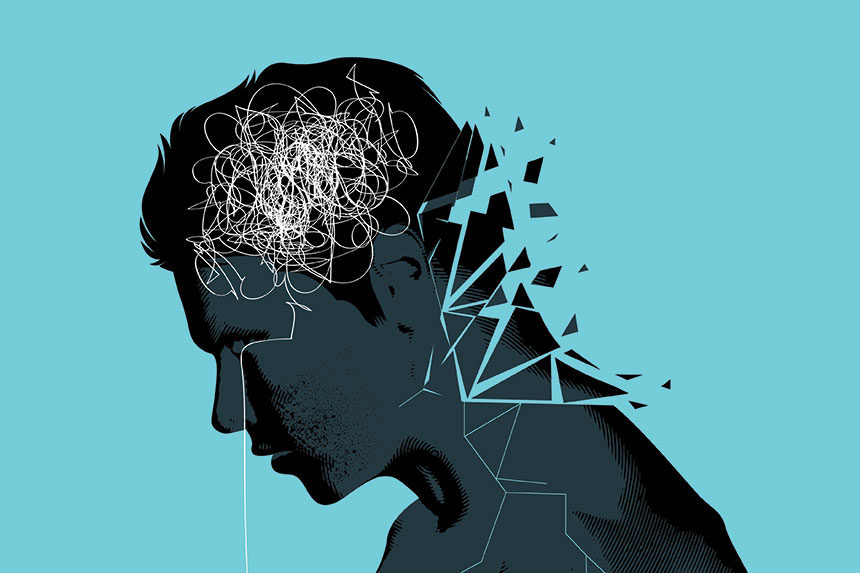For the past several decades, America’s psychiatric hospitals have been in a state of emergency. There are too few psych beds for too many bodies. Only extreme cases — like the time a woman bit off her own finger because the voices told her to — get quick care. “This is the sad part of this work. People so psychotic they can’t even get to the hospital without doing something terrible to themselves,” nurse manager Jean Horan told the San Francisco Gate in 2006. Former Bay Area E.R. psychiatrist Dr. Paul Linde described the revolving-door policy in 2018: “You’ve got your chow, you’ve got your shower, you’ve got your medication, you’ve got some sleep, and now it’s time to get out the door.”
Patients are often taken by ambulance to emergency rooms, where they are boarded in general acute hospitals that lack psychiatric care. The hospitals then can’t discharge their patients to psychiatric facilities because, more often than not, there are no beds available. It creates a logjammed system that fails everyone, as movement is stymied in almost every direction except to the streets or to jails and prisons, also known as “the beds that never say no,” said Mark Gale, criminal justice chair of the National Alliance on Mental Illness (NAMI). “These are the choices we are making as a society, because we refuse to fund the completion of our mental health system.”
The U.S. is a minimum of 95,000 beds short of need. It’s now harder to get a bed in New York City’s Bellevue Hospital than it is to land a spot at Harvard University, wrote advocate D.J. Jaffe in his devastating 2018 book Insane Consequences. Sixty-five percent of the non-urban counties in the United States have no psychiatrists, and nearly half lack psychologists, too. If the situation continues as it is, by 2025, we can expect a national shortage of 15,000 desperately needed psychiatrists as medical students seek higher-paying specialties and 60 percent of our current psychiatrists gray out.
And even if you did have access to decent psych care, you’d face the following obstacles: “One or more nurses would take vital signs, complete a brief exam, and gather some of the patient’s history. At least one emergency physician would repeat the process. … The emergency physicians might order a CT scan of the head or other imaging, depending on the patient’s history. … A psychiatrist would review the patient’s chart and any available electronic records. … From start to finish, these evaluations can take hours,” wrote Stanford psychiatrist Nathaniel Morris in the Washington Post.
Most states require that for a person to be hospitalized, she would need to pose a threat or be so gravely disabled and, according to a psychologist, “so disorganized that she would just stand in front of the facility, wander aimlessly in the street, or perhaps stand in the middle of a busy street, with no notion of how to get food or lodging for herself.”
One psychiatric nurse laid out what kind of acting it takes to get care. In the emergency department, “when being assessed, say (regardless of the truth): ‘I am suicidal, I have a plan and I do not feel safe leaving here. My psychiatrist asked me to come here for admission for personal safety feeling I am a grave danger to myself.’ That statement get[s] you back to the psychiatric [emergency department]. Once there, you get interviewed by the psychiatric triage nurse. Repeat the same statement.” Only once past these various gatekeepers, onto the psych floor, and in a bed can the patient start telling people what is truly wrong.
“There’s no way we’d send people who have diagnosed pancreatic cancer to jail because there’s no place to put them while they get treatment.
A 2015 study published in Psychiatric Services documented what happened when a team of researchers posed as patients and called around to psychiatric clinics in Chicago, Houston, and Boston trying to obtain an appointment with a psychiatrist. Of the 360 psychiatrists contacted, they were only able to obtain appointments with 93 — or 25 percent of the sample. (This says nothing of the wait time required for the appointment, nor of the care they would — or would not — receive.)
Dr. E. Fuller Torrey, who founded the Virginia-based Treatment Advocacy Center dedicated to “eliminating barriers to the timely and effective treatment of severe mental illness,” said it directly: “People with schizophrenia in the United States were better off in the 1970s than they are now. And this is really something that all of us in the United States are responsible for.”
After too many reports of abuses, there was a wave of psychiatric hospital closings starting in the late 1960s. “Reformers” believed that community care was a much better way to treat most patients, but those promises never materialized, and thousands of people were turned out from hospitals (where some had spent most of their lives) and had nowhere to go. In the 1970s, 5 percent of people in jail fit the criteria for serious mental illness. Now it’s 20 percent, or even higher. Nearly 40 percent of prisoners had, at some point, been diagnosed with a mental health disorder, and the most common diagnoses are: major depressive disorder (24 percent), bipolar disorder (18 percent), post-traumatic stress disorder (13 percent), and schizophrenia (9 percent). Women, the fastest growing segment of America’s inmate population, are more likely to report having a history of mental health issues.
These figures also disproportionately affect people of color, who “are more likely to suffer disparities in mental health treatment in general, which results in their being more likely to be ushered into the criminal justice system,” said Dr. Tiffany Townsend, senior director of the American Psychological Association’s Office of Ethnic Minority Affairs.
There are, at last count in 2014, nearly ten times more seriously mentally ill people who live behind bars than in psychiatric hospitals. The largest concentrations of the seriously mentally ill reside in Los Angeles County, New York’s Rikers Island, and Chicago’s Cook County — jails that are now de facto asylums. As someone who knows what it’s like to lose her mind, the only worse place I can imagine for someone going through that than a jail is a coffin.
“Many of the persons with serious mental illness that one sees today in our jails and prisons could have just as easily been hospitalized had psychiatric beds been available. This is especially true for those who have committed minor crimes,” said University of Southern California psychiatrist Richard Lamb, who has spent the bulk of his half-century career studying and writing about these issues.
This is the current state of mental health care in America — the aftershock of deinstitutionalization, which some call transinstitutionalization, the movement of mentally ill people from psychiatric hospitals to jails or prisons, and others call the criminalization of mental illness. Whatever term you want to use, experts agree that what has resulted is a travesty.
“A crisis unimaginable in the dark days of lobotomy and genetic experimentation” (Ron Powers in No One Cares about Crazy People); “one of the greatest social debacles of our times” (Edward Shorter, A History of Psychiatry); “a cruel embarrassment, a reform gone terribly wrong” (The New York Times).

Though some credit the rise in the mentally ill population behind bars to the fact that America has the highest incarceration rate in the world and to policies like mandatory minimum sentencing and three-strike laws, it’s clear that whatever the cause, the fallout has been disastrous.
“Behind the bars of prisons and jails in the United States exists a shadow mental health care system,” wrote University of Pennsylvania medical ethicist Dominic Sisti. People with serious mental illness are less likely to make bail, and they spend longer amounts of time in jail. At Rikers Island, which is in the process of shuttering, the average stay for a mentally ill prisoner was 215 days — five times the non-ill inmate average. The ACLU filed a lawsuit against Pennsylvania’s Department of Human Services on behalf of hundreds of people who had been declared incompetent by the court. Problem was, there were no beds available, so they were left in jails — in one case in Delaware County, a mentally ill person, too incompetent to stand trial, languished in jail for 1,017 days. The lawsuit’s lead plaintiff is “J.H.,” a homeless man who spent 340 days in the Philadelphia Detention Center awaiting an open bed at Norristown State Hospital for stealing three Peppermint Pattie candies. During that time, “J.H.” had a greater chance of becoming a victim of assault and sexual violence — all because he was too sick to go to trial. In March 2019, the ACLU took the DHS back to court after it “failed to produce constitutionally acceptable results, with some patients remaining in jails for months at a time.”
In Arizona, men “often nude, are covered in filth. Their cell floors are littered with rancid milk cartons and food containers. Their stopped-up toilets overflow with waste,” wrote Eric Balaban, an ACLU lawyer who chronicled his visit to Phoenix’s Maricopa County Jail’s Special Management Unit in Phoenix in 2018. In California, “Inmate Patient X” at the Institution for Women in Chino in 2017 was not given medication despite being listed as “psychotic,” and, after being ignored in her cell after screaming for hours, ripped her own eye out of her skull and swallowed it. In Florida, Darren Rainey was forced into a “special” shower by prison guards. The shower’s temperature climbed to 160 degrees, which peeled his skin off “like fruit rollups” and killed him. In Mississippi, “a real 19th-century hell hole,” non–mentally ill prisoners sell rats to the mentally ill prisoners as pets. In the same place, a man was reported fine and well for three days after he suffered a fatal heart attack. And in the shadow of Silicon Valley, a man named Michael Tyree screamed out “Help! Help! Please stop” as he was beaten to death by prison guards while awaiting a bed in a residential treatment program.
It all reminds me of Erving Goffman’s Asylums. Goffman was a sociologist who went undercover at Washington D.C.’s St. Elizabeths Hospital and argued that what he saw there was a “total institution,” no different from prisons and jails. He cited examples: the lack of barriers between work, play, and sleep; the remove between staff and “inmate”; the loss of one’s name and possessions.
“It’s true that the hospitals have mostly disappeared,” wrote Alisa Roth in her 2018 book Insane. “But none of the rest of it has gone away, not the cruelty, the filth, the bad food, or the brutality. Nor, most importantly, has the large population of people with mental illness who are kept largely out of sight, their poor treatment invisible to most ordinary Americans.”
And then there’s therapy — or the farce that passes for it in some prisons. Treatment is often rare and mostly revolves around medication management. When therapy does occur in certain jails in Arizona and Pennsylvania, it involves doctors or social workers speaking to patients through the metal slats in closed cell doors or, in one egregious case, merely handing out coloring books, wrote Roth.
“Prisoners are under a tremendous amount of stress, and they feel a tremendous amount of pain, and they’re not encouraged to think about that. In fact, there’s an incentive not to think about it or talk about it, because nobody is interested in it,” said Craig Haney, a psychologist who studies the effects of incarceration.
The culture of distrust goes both ways. Many guards grapple with threats (real or imagined) that the inmates are malingering or faking because they want out of a bad situation in the general population or feel they’ll get a cushier housing assignment among “the crazies.” Though this does happen, David Fathi, director of the ACLU’s National Prison Project, said that this is not as common as it’s portrayed. More often, people are underdiagnosed and mismanaged: “I mean people who have documented histories of mental illness going back to when they were nine, they get to prison and suddenly they’re not mentally ill, they’re just a bad person.”
Craig Haney agreed, adding that there’s no real incentive to lie and game the system: “What’s the secondary gain?” The secondary gain is that they get taken out of one miserable cell and put into another one that is usually more miserable. If they put you in a suicide watch cell — then you’re in an absolutely bare cell with no property whatsoever, sometimes you’re in a suicide smock, and sometimes they take all of your clothes away and leave you there naked.”
Dr. Torrey does have some solutions. The Treatment Advocacy Center, which he founded, advocates for adding more beds across the board — in state hospitals and forensic settings — which would reduce wait times and get people out of jails and into proper treatment quicker. D.J. Jaffe, a self-described “human trigger warning” and executive director of the Mental Illness Policy Organization, pushes for the implementation of more mental health courts, where judges can divert people with mental illness into appropriate housing and treatment before they’ve been absorbed into the prison system. He also backs the use of crisis intervention teams made up of law enforcement officers, with the assistance of psychiatric professionals, trained to identify and deal with people with serious mental illness. On the more controversial end, Jaffe has written extensively about the necessity of using legal force to get people to take their meds (something called Assisted Outpatient Treatment), pointing out that many people with serious mental illness don’t know that they’re sick (a symptom called anosognosia), and for civil commitment reforms so that more people can be hospitalized against their will before tragedy strikes. He and Torrey have both made the case that though the vast majority of people with serious mental illness are no more violent than people without mental illness, studies have shown that a small subset of people, who are typically untreated, are more violent. To those who say these policies infringe on people’s civil liberties, Jaffe has responded: “Being psychotic is not an exercise of free will. It is an inability to exercise free will.”
Some prisons and jails, resigned to their new roles, have implemented changes to reflect their true roles as society’s mental health care providers. Sheriff Tom Dart of Chicago’s Cook County jail, where a third of the 7,500 prisoners struggle with mental illness, has become a standard-bearer in doing the best with an untenable situation. “Okay, if they’re going to make it so that I am going to be the largest mental health provider, we’re going to be the best ones,” he told 60 Minutes in 2017. “We’re going to treat ’em as a patient while they’re here.” Cook County provides medication management, group therapy, and one-on-one visits with psychiatrists. Sixty percent of the staff has advanced mental health training, and the jail warden is a psychologist.
But we need money to enact real changes. Without the proper allocation of funds, we punish people three times: disinvesting from resources to support them in the first place, arresting them when they exhibit problematic behavior, and then hanging them out to dry when they reenter the community. The system remains broken and people who are sickest continue to be ignored and forsaken.
“If I told you that was the case for cancer or heart disease, you’d say no way, we’re not going to send people who have freshly diagnosed pancreatic cancer to jail because there’s no place to put them while they get treatment,” said Dr. Thomas Insel, former head of the National Institute of Mental Health. “But that’s exactly the situation we’re facing.”
Excerpted from The Great Pretender: The Undercover Mission That Changed Our Understanding of Madness. Copyright © 2019 by Susannah Cahalan, LLC. Reprinted with permission of Grand Central Publishing. All rights reserved.
Featured image: Shutterstock
Become a Saturday Evening Post member and enjoy unlimited access. Subscribe now



